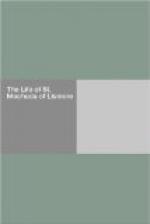There are many indications in the present Life that, at one period, and in the time of Carthach, the western boundary of Decies extended far beyond the line at present recognised. Similar indications are furnished by the martyrologies, &c.; for instance, the martyrology of Donegal under November 28th records of “the three sons of Bochra” that “they are of Archadh Raithin in Ui Mic Caille in Deisi Mumhan” and Ibid, p. xxxvii, it is stated “i ccondae Corcaige ataid na Desi Muman.” Not only Imokilly but all Co. Cork, east of Queenstown [Cobh] and north to the Blackwater, seems to have acknowledged Mochuda’s jurisdiction. At Rathbreasail accordingly (teste Keating, on the authority of the Book of Cloneneigh) the Diocese of Lismore is made to extend to Cork,—probably over the present baronies of Imokilly, Kinatallon, and Barrymore. That part, at least, of Condons and Clangibbon was likewise included is inferrible from the fact that, as late as the sixteenth century visitations, Kilworth, founded by Colman Maic Luachain, ranked as a parish in the diocese of Lismore. Further evidence pointing in the same direction is furnished by Clondulane, &c., represented in the present Life as within Carthach’s jurisdiction.
The Rule of St. Carthach is one of the few ancient Irish so-called monastic Rules surviving. It is in reality less a “rule,” as the latter is now understood, than a series of Christian and religious counsels drawn up by a spiritual master for his disciples. It must not be understood from this that each religious house did not have it formal regulations. The latter however seem to have depended largely upon the abbot’s spirit, will or discretion. The existing “Rules” abound in allusions to forgotten practices and customs and, to add to their obscurity, their language is very difficult—sometimes, like the language of the Brehon Laws, unintelligible. The rule ascribed to Mochuda is certainly a document of great antiquity and may well have emanated from the seventh century and from the author whose name it bears. The tradition of Lismore and indeed of the Irish Church is constant in attributing it to him. Copies of the Rule are found in numerous MSS. but many of them are worthless owing to the incompetence of the scribes to whom the difficult Irish of the text was unintelligible. The text in the Leabhar Breac has been made the basis of his edition of the Rule by Mac Eaglaise, a writer in the ’Irish Ecclesiastical Record’ (1910). Mac Eaglaise’s edition, though it is not all that could be desired, is far the most satisfactory which has yet appeared. Previous editions of the Rule or part of it comprise one by Dr. Reeves in his tract on the Culdees, one by Kuno Meyer in the ’Gaelic Journal’ (Vol. V.) and another in ‘Archiv fuer C.L.’ (3 Bund. 1905), and another again in ‘Eriu’ (Vol. 2, p. 172), besides a free translation of the whole rule by O’Curry in the ‘I. R. Record’ for 1864. The text of the ‘Record’




